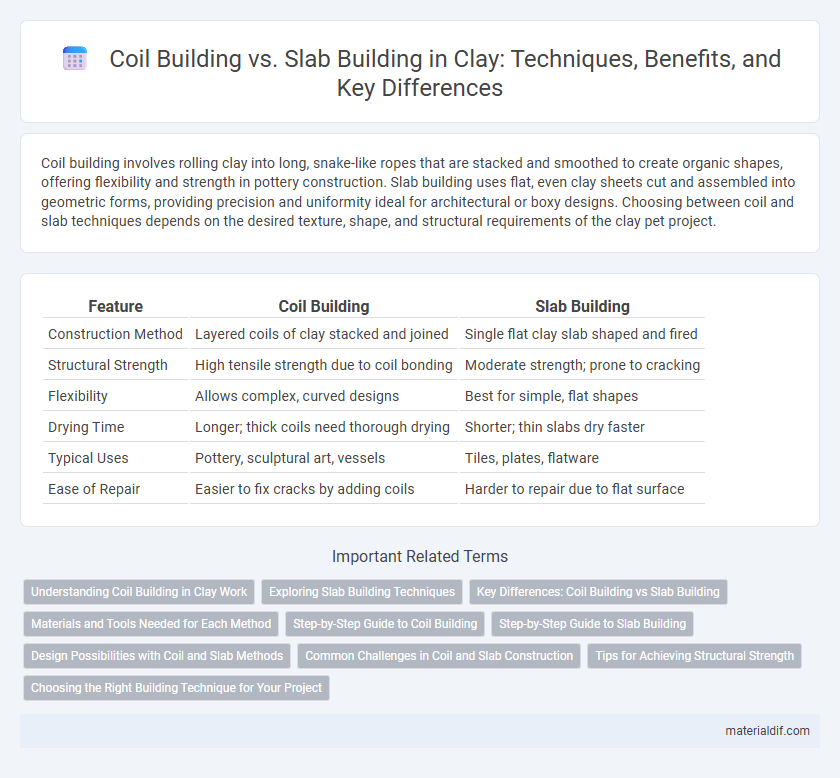Coil building involves rolling clay into long, snake-like ropes that are stacked and smoothed to create organic shapes, offering flexibility and strength in pottery construction. Slab building uses flat, even clay sheets cut and assembled into geometric forms, providing precision and uniformity ideal for architectural or boxy designs. Choosing between coil and slab techniques depends on the desired texture, shape, and structural requirements of the clay pet project.
Table of Comparison
| Feature | Coil Building | Slab Building |
|---|---|---|
| Construction Method | Layered coils of clay stacked and joined | Single flat clay slab shaped and fired |
| Structural Strength | High tensile strength due to coil bonding | Moderate strength; prone to cracking |
| Flexibility | Allows complex, curved designs | Best for simple, flat shapes |
| Drying Time | Longer; thick coils need thorough drying | Shorter; thin slabs dry faster |
| Typical Uses | Pottery, sculptural art, vessels | Tiles, plates, flatware |
| Ease of Repair | Easier to fix cracks by adding coils | Harder to repair due to flat surface |
Understanding Coil Building in Clay Work
Coil building in clay work involves rolling long, snake-like strands of clay and layering them to create forms, offering flexibility and control over shapes that slab building lacks. This technique allows for more organic, rounded structures and better structural integrity during construction. Understanding coil building enhances craftsmanship by enabling the creation of both functional pottery and intricate sculptural pieces with precise texture and thickness variations.
Exploring Slab Building Techniques
Slab building techniques in clay involve rolling out flat sheets of clay and cutting them into shapes that are assembled to create geometric, architectural forms, offering precise control over thickness and structure. This method allows for intricate surface designs and textural effects by impressing patterns or layering different clay types, enhancing both aesthetic and functional qualities. Compared to coil building, slab building is often faster and produces more uniform walls, making it ideal for creating modern, angular pottery or sculptural pieces.
Key Differences: Coil Building vs Slab Building
Coil building involves stacking and blending long, rolled ropes of clay to create walls with organic curvature, offering flexibility in shape and texture. Slab building uses flat, even sheets of clay that are cut, joined, and layered to form geometric, angular structures. The primary difference lies in coil building's emphasis on hand-rolled clay ropes versus slab building's use of rolled flat planes for construction.
Materials and Tools Needed for Each Method
Coil building requires pliable clay rolled into long, even strands and tools such as a rolling pin, knife, rib, and slip for joining coils securely. Slab building involves rolling out flat, consistent clay sheets using a slab roller or rolling pin, along with cutting tools like knives or wire cutters and scoring tools to ensure proper adhesion between slabs. Both methods benefit from sponges, modeling tools, and a kiln for finishing, but coil building prioritizes hand-shaping tools, while slab building depends more on flat, uniform surfaces.
Step-by-Step Guide to Coil Building
Coil building involves rolling long, snake-like strands of clay and stacking them to create a vessel or sculpture, ensuring each coil is carefully scored and slipped to bond securely. The process begins with forming a solid base, followed by adding coils layer by layer while smoothing the interior and exterior surfaces to achieve structural stability. This traditional technique allows for organic shapes and textured finishes, offering versatility compared to slab building, which uses flat, rolled-out clay pieces.
Step-by-Step Guide to Slab Building
Slab building involves rolling out flat clay slabs and cutting them into shapes to assemble pottery or sculptures, allowing for precise control over thickness and form. Begin by preparing an even, smooth slab using a rolling pin or slab roller, then use templates or freehand cutting tools to shape your pieces before scoring and slipping the edges for secure joining. This technique is ideal for creating geometric forms and planar surfaces, offering versatility that contrasts with coil building's reliance on stacking and blending rolled clay ropes.
Design Possibilities with Coil and Slab Methods
Coil building offers greater flexibility in creating organic, curved forms and intricate textures due to its layered approach, allowing artists to manipulate shapes with precision. Slab building excels in producing geometric, angular designs and flat surfaces that can be joined to form complex structures with consistent thickness. Combining coil and slab methods expands creative possibilities, enabling the construction of both fluid contours and sharp edges in ceramic artworks.
Common Challenges in Coil and Slab Construction
Coil building in clay pottery often struggles with uneven wall thickness and air pockets, causing structural weaknesses and potential cracking during drying or firing. Slab construction faces challenges like poor adhesion between slabs leading to weak joints and warping as slabs dry at different rates. Both techniques require careful control of moisture content and consistent surface scoring to ensure durability and prevent deformation.
Tips for Achieving Structural Strength
Coil building enhances structural strength in clay by layering rolled coils in spiral patterns, allowing for gradual drying and even thickness that prevents cracking. Slab building requires scoring and slipping edges carefully to ensure strong bonds between flat clay pieces, creating a stable, unified form. Consistent moisture control and gradual drying times are essential for both methods to avoid warping and maintain durability in finished clay structures.
Choosing the Right Building Technique for Your Project
Coil building offers flexibility and strength, making it ideal for creating rounded, organic shapes and larger vessels with consistent wall thickness. Slab building excels in precision and structure, allowing for flat surfaces, sharp angles, and complex geometric forms in projects requiring stability and uniformity. Selecting the right technique depends on the desired aesthetic, functional requirements, and complexity of the ceramic piece.
Coil Building vs Slab Building Infographic

 materialdif.com
materialdif.com